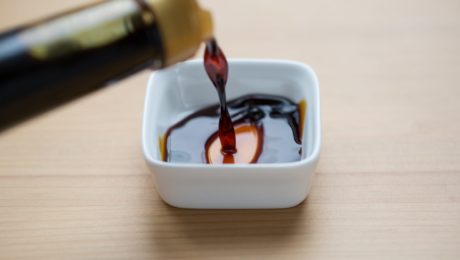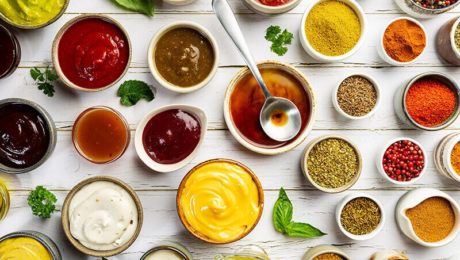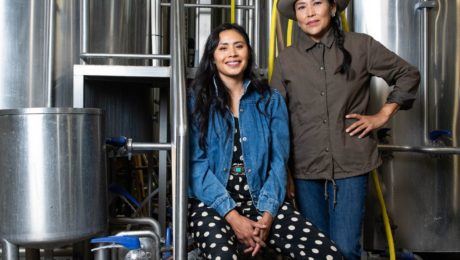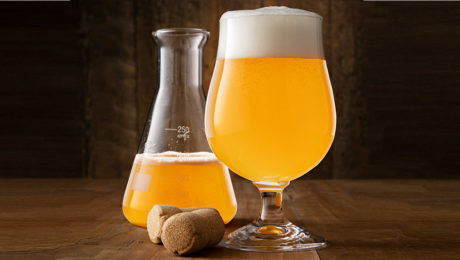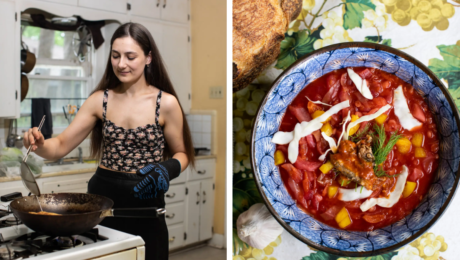The Complex Flavors of Soy Sauce
One of the oldest condiments in the world, soy sauce has been a staple in Asian dishes for thousands of years. The complex, umami flavor profile created by fermenting soy beans has fascinated chefs and scientists alike. Now, a new study has found over 50 flavor compounds in soy sauce.
“Decoding the flavours of this fermented food is particularly challenging because of the complex processes involved in its creation, including the microbial breakdown of compounds over time,” reads a press release by the American Chemical Society (ACS). The results of the study were published in the Journal of Agricultural and Food Chemistry.
Scientists at ACS began with the question: “Soy sauce deepens the flavor of soup stocks, gives stir-fried rice its sweet-salty glaze and makes a plate of dumplings absolutely enjoyable. But what exactly makes this complex, salty, umami sauce so tasty?”
They identified soy sauce’s flavor profile by using “tastants,” the chemical that produces a taste sensation replicating the flavor of food. This assessment identified 34 key tastants that replicated the taste of soy sauce. But the team of flavor assessors said something was not quite right “it wasn’t quite as salty or as bitter as the authentic product. The team then searched for other, unknown flavor compounds, hypothesizing that small proteins could potentially be the missing ingredient.” So scientists implemented sensoproteomics, a new method for identifying taste-active peptides in fermented foods. “…they identified a collection of proline-modified dipeptides and other larger, newly identified proteins that enhanced umami and other flavors.” The final recreated sample contained over 50 individual flavor compounds.
This analysis yielded another interesting result. Salt has long been thought to be the primary element giving soy sauce its kick. But the researchers found that saltiness wasn’t due to salt – it comes from a combination of peptides and proteins. These peptides could potentially be a healthier seasoning alternative to table salt.
Understanding the flavor profile of soy sauce could help in tailoring manufacturing processes to ensure consistent quality and boost certain flavors.
- Published in Food & Flavor
“Next Level Fermentation”
“Fermented and Flourishing” is what Whole Foods Market calls the growing world of fermented condiments. The retailer’s Trends Council released their first-ever summer condiments trends predictions.
“These days, fermented foods are an unstoppable force charging through aisle after aisle with a full head of steam. Condiments are no exception,” reads the press release. “We’re seeing tangy fermented ingredients adding flair to vinaigrettes, hot sauces, honeys and mayos. With flavor boosts like miso, kimchi and fermented garlic, these products exponentially expand the flavor possibilities of every summer soirée.”
Sales for the condiment, marinade and dressing categories are expected to hit $2.9 billion by 2024, according to market research firm Mintel.
Whole Foods’ list highlighted emerging and established fermented condiments: Lucky Foods Seoul Kimchi Mayo, Cleveland Kitchen’s line of fermented dressings and marinades, California Olive Ranch Carrot Miso Vinaigrette, Firefly Kitchens Kimchi Hot Sauce and Ninja Squirrel Coconut Sriracha Hot Sauce.
Read more (Whole Foods Market)
- Published in Business, Food & Flavor
Championing Indigenous Brewers
The headline says it all: “The Country’s First Native American Woman-Owned Brewery in the U.S. Doesn’t Want to Be Its Last.”
Co-founders Shyla Sheppard (who has heritage from the Three Affiliated Tribes – Mandan, Hidatsa and Arikara – of North Dakota) and her business partner and wife, Dr. Missy Begay (Diné heritage) founded Bow & Arrow Brewing Co. in 2016. The brewery has become known for wild and sour beers made with cultivated yeast. They forage for neomexicanus hops, a species found in New Mexico. Local and indigenious ingredients – like blue corn, sumac, prickly pear and juniper – are used in a new line of hard seltzers.
Bow & Arrow began a unique initiative on October 11, 2021, Indigenous Peoples’ Day. The brewery launched Native Land. They provided an IPA recipe to breweries across the U.S. to create a beer for a common mission: “to acknowledge the contributions and history of Native American people in the United States.” Participating breweries were given a can design template, which included space to acknowledge the tribal land where the brewery is located.
The campaign was so popular – 53 breweries in 24 states and one Canadian province brewed Native Land beer – that they extended the deadline for the project to September 2022. The beers are “vehicles for activism,” with a portion of proceeds going to a Native American-operated nonprofit of the brewer’s choice.
“We’re reclaiming our history and narrative. I think the contributions that Native people have had to agriculture have been erased or dismissed. It’s important to share that story to non-Native people, but also to other Native folks,” she says. “I think fostering that appreciation and connection to our history brings about healthier Native communities.”
Bow & Arrow is one of only a small number of Native-owned breweries in the U.S. – but Sheppard and Begay hope that will change and, one day, there will be more. Sheppard adds: “Having done what we’ve done — in what I hope is a respectful way of incorporating our culture and background — I think it’s inspiring other brewers.”
Read more (Eater)
- Published in Business, Food & Flavor
“Fermentation…a form of magic”
“Fermentation is hope for trans folks. If people can conceptualize cucumbers becoming pickles, then they can grasp a trans person’s name change. If the possibility of Camembert, Parmesan, and ricotta exist within milk, then think of all the possible genders to choose from!” reads an article in Bon Appetit.
The magazine published an article by transgender cheesemaker-turned-journlaist H. Conley who, while immersed in the world of cheesemaking and the fermentation of milk into cheese, realized they were trans. The article’s accompanying illustration (pictured) by artist Jasjyot Singh Hans is called “Trans-Fermentation.”
Conley writes: “I didn’t see trans fermenters as a pattern until June Henry Hyde, a trans 18-year-old from Kansas, told me her plans to start a pickling business with her nonbinary partner. She showed me the self-administered tattoos on her forearm: a pickled pepper jar next to a star-topped wand.”
“I consider fermentation to be a form of magic,” she told me. For her, transition is magic as well. It takes magic to manifest desired realities. “But there’s this other layer of people who are really averse to fermented foods, like ‘It’s different, it’s undergone this transformation that’s made it less desirable,’” she added. The otherworldly SCOBY in kombucha, the stinging fragrance of kimchi, the very concept of eating mold makes some resistant to giving fermented foods a chance. “It’s seen as an acquired taste in some cases, which resonates with me a lot as a trans person.”
Read more (Bon Appetit)
- Published in Food & Flavor
Mixed Culture Beer Fermentation
Just because you’ve pitched an exotic fermenting agent into your beer doesn’t mean the hard work is done. Mixed-culture fermentations are becoming increasingly popular choices for brewers looking to add complexity to their beers. But, as an article in Craft Beer & Brewing details, using a mixed array of yeasts and bacteria requires greater attention to the fermentation process.
“Just because it’s a wild beer doesn’t mean that you can be careless,” says Patrick Chavanelle, R&D brewer at Allagash in Portland, Maine. “Be as meticulous when crafting a mixed-fermentation beer as you would when brewing a beautifully crisp lager.”
Mixed fermentation uses multiple microorganisms as fermenting agents. The most common are yeasts Saccharomyces (known as brewer’s yeast) and Brettanomyces, and the bacteria Lactobacillus and Pediococcus.
The article advises brewers to: embrace uncertainty, focus on pitch rate, pay attention to choice of fermentor, research the yeast or bacteria used and consider post-fermentation doctoring.
Read more (Craft Beer & Brewing)
- Published in Food & Flavor
Making Mead
Mead appealed to David Lane because of the fermentation challenge: it’s hard to make a bad wine, but easy to make a bad mead.
“Honey sometimes needs various chemical nudges,” he said. “It’s a big puzzle figuring out how to get the chemistry just right for each varietal.”
His Oregon-based brand, Wild Nectar Mead, is made with honey from local honeybees. Interacting with their beekeepers made Lane even more passionate about mead. He learned about the dangers of honeybee extinction and the importance of local pollinators. He calls it his “bee-cause.”
Each mead flavor reflects the essence of a variety of honey, such as basswood, clover or wildflower. Lane says he loves these flavor differences.
Lane also has taken a different approach to production. Many purists believe a good mead needs months-long fermentation. Lane has tinkered with a process that takes only a month.
“(Mead) has a long history, but then it fell out of favor with history,” Lane said. “So it feels like a comeback drink to a lot of people.” Read more (auburnpub.com)
- Published in Food & Flavor
Saving Ukrainian Food Culture
When the war in Ukraine broke out, Olga Koutseridi, a Ukrainian American baker, writer and historian, felt an urgent need to preserve the traditional Ukrainian recipes she grew up with.
Koutseridi’s ancestors tended gardens outside Mariupol. They preserved the food they couldn’t eat, fermenting tomatoes, cucumbers, cabbage and sour cherries. They drank homemade kombucha, kefir and vodka. They made varenyky (dumplings stuffed with sour cherries and cheese) and chebureki (fried pastry filled with meat).
“Maybe now is not the time to celebrate Ukrainian food,” Koutseridi said. “But this feels like the only chance we have to preserve it. … Every time someone makes a Ukrainian dish in an American kitchen, it’s an act of resistance.”
Koutseridi has begun compiling these recipes, with an emphasis on history. She’s contacted Ukrainian food experts around the world (including Olia Hercules, author of Summer Kitchens).
She feels that war is destroying Ukraine’s identity, history and culture.“Now is the time to delve into{the country’s] food in detail,” Hercules said. “There’s so much more to it than borsch.”
Read more (The New York Times)
- Published in Food & Flavor
Mead’s Modern Moment
“Somewhere between wine, beer, and cider lives mead. An ancient libation like no other, mead has been a pleasant surprise to drinkers for eons. Norsemen would be thrilled to know that it has made a modern-day comeback.”
Mead was highlighted in an article in Tasting Table, “appreciated by everyone from Vikings to millennials.” Also known as honey wine, it is experiencing a modern resurgence. Mead makers are adding unique seasonings and spices to enliven their creations – but it needs to be at least 51% wine.
More meaderies are popping up – there is now at least one in every U.S. state. But liquor stores are still confused on where to put meads. The national sales manager of Chaucer’s Cellars – the country’s longest-running meadery – says most stores have no clue where to display mead.
Read more (Tasting Table)
- Published in Business, Food & Flavor
Chef’s Secret: Fermented Bean Curd
Chef Andrew Wong created the first Michelin two-star Chinese restaurant outside Asia. His London-based A Wong is an homage to China’s 3,000-year culinary history and a contemporary spin on the country’s regional cuisine.
Fermented wild sea bass and fermented coconut are part of the “Taste of China” dinner menu. A popular dish called “Why the Buddha Didn’t Jump Over the Wall” is barbecued sweet potato covered in a fermented, salted black-bean relish. It’s no surprise Wong’s favorite ingredient is fermented bean curd. He says the tofu, soaked in salt and chili, is as close to cheese as you can get in China. It’s eaten with congee and used as a condiment.
“It’s very salty; umami in its purest form,” Wong says. “I use it a lot in my cooking, especially in vegetarian dishes where we can’t use oyster sauce. We cook it out with some stock, ginger, garlic, and make a sauce. The combination of vegetables, garlic, chili and fermented bean curd creates a really deep meaty flavor.”
He advises chefs to use it like a stock cube, because it’s soft and will coat the mouth in umami flavor.
Read more (Guardian)
- Published in Food & Flavor
The State of Fermentation Education
The Covid-19 lockdown spurred aspiring home chefs around the world to try fermenting for the first time. DIY classes moved virtual and countertops filled with bubbling crocks of kimchi, sauerkraut, kombucha and sourdough. Fermentation was one of the top pandemic hobbies.
For professional fermentation educators, this trend brought new, eager faces to classes. But now, as lockdown restrictions have eased, are people still wanting to experiment making their own microbe-rich food?
We asked three experts to share their thoughts on the current state of fermentation education — author and educator Kirsten Shockey (of The Fermentation School and Ferment Works), writer and educator Soirée-Leone (who can be found via her website) and chef, food scientist and fermentation educator Jori Jayne Emde (of Lady Jayne’s Alchemy and The Fermentation School). [Shockey and Soirée-Leone are both members of TFA’s Advisory Board.]
The question: What is the current state of fermentation education?
Kirsten Shockey, author and educator
Fermentation education is exploding. The time has never been better. The interest in fermentation — both as a topic and in hands-on engagement — keeps gaining momentum. People are both more curious and more confused than I have seen in the past. I think part of that is because with the boom of interest a lot of people are coming forward as experts sharing content without the prerequisites to inform accurately. For example, we see misinformation about the subtle differences in fermentation vs. culturing vs. pickling that end up leaving people who are just dipping their toes in the process a little less unsure. When these folx do engage with true experts they are enthusiastic students who enjoy soaking up all that they can and we see their anxieties dissipate. I speak from the experience of working with solid experts and their students through The Fermentation School. It has been beyond gratifying to work with an amazing group of really talented fermentation educators to grow quality online education and a dedicated “help” community through The Fermentation School. In my other educator hat, as an author, it is less clear to me how that media is working for education, but that is a bigger issue in that the publishing world itself is in a lot of flux.
Soirée-Leone, writer and educator
Folks are connecting with familial, cultural, and traditional roots through fermentation. They are building online communities to share knowledge, taking workshops, participating in residencies, checking books out from libraries, and attending fermentation festivals that are popping up all over the world.
While there is an abundance of information available through books and websites, some folks seek to connect in person through workshops. I find that it’s especially dynamic to teach and learn in collaborative environments to share skills and experiences. There are so many traditions, techniques, and riffs. It is exciting to learn about folks’ travels, study, and experiments — we each have a different fermentation journey and something to teach and learn.
Today is a far cry from when I first started cheesemaking in 1991 with one slim book that sang the praises of junket rennet. Now there are books sharing natural cheesemaking techniques, bloggers happy to answer questions, travelers bringing information home and sharing online, and workshops to attend.
Fermentation is accessible with rudimentary kitchen equipment and improvised incubators and cheese caves. Fermentation is empowering and engaging of all our senses—and learning new things about fermentation is a never-ending journey.
Jori Jayne Emde, chef, food scientist, fermentation educator
My perspective on this is it’s booming! There was a huge burst of interest for online learning during the pandemic, and I have not seen that slow down much. Fermentation is a trendy topic and word with, unfortunately, a tremendous amount of misinformation floating around out there. It’s an important time as an educator to really remain engaged with students, as well as capturing fermentation aspirants, guiding them towards proper and well informed education taught by experts in the field of fermentation and health.
- Published in Food & Flavor

